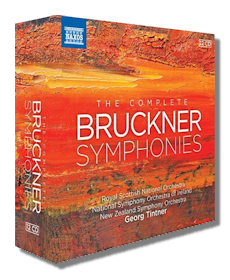
The Internet's Premier Classical Music Source
Related Links
- Bruckner Reviews
- Latest Reviews
- More Reviews
-
By Composer
-
Collections
DVD & Blu-ray
Books
Concert Reviews
Articles/Interviews
Software
Audio
Search Amazon
Recommended Links
Site News
 CD Review
CD Review
Anton Bruckner

The Complete Symphonies
- "Study" Symphony in F minor (1863 - Nowak)
- Symphony #0 in D minor "Die Nulte" (1869 - Nowak)
- Symphony #1 in C minor (1866 - Linz; Carragan)
- Symphony #2 in C minor (1872 - Carragan) *
- Symphony #3 in D minor "Wagner" (1873 - Nowak)
- Symphony #4 in E Flat Major "Romantic" (1881 - Haas)
- Symphony #5 in B Flat Major (1878 - Nowak/Haas)
- Symphony #6 in A Major (1881 - Haas) **
- Symphony #7 in E Major (1883 - Haas)
- Symphony #8 in C minor (1887 - Nowak) *
- Symphony #9 in D minor (1896 - Nowak) *
Royal Scottish National Orchestra/Georg Tintner
* National Symphony Orchestra of Ireland/Georg Tintner
** New Zealand Symphony Orchestra/Georg Tintner
Naxos 8.501205 12CDs
Georg Tintner's Bruckner cycle played a key role in getting Naxos taken seriously as a record label, rather than as a producer of low-price CDs. Naxos have recently re-released the entire cycle in an attractive 12-disc box and at a super-bargain price. The cycle was originally released in 2002 in Naxos's White Box series, but has been hard to obtain for some time, and so this is a welcome reissue.
The box contains a very useful booklet with 32 pages of notes by Tintner himself, including an analysis of each symphony, a chronology that contextualizes the symphonies, and a discussion of Tintner's often idiosyncratic choice of editions. Disc 12 in the set is lecture that Tintner gave to the National Youth Orchestra of Canada, including a detailed analysis at the piano of the slow movement of the Seventh. This lecture was not included in the original White Box issue and is an insightful and moving account of Tintner's deep engagement with Bruckner's music – reminiscent of the wonderful discussion accompanying Benjamin Zander's Telarc recording of the Fifth Symphony with the Philharmonia.
Generally speaking, Tintner's instinct is to go with Bruckner's original thoughts. He stresses Bruckner's deep insecurity and desire to be performed, stating in the booklet: "although adversaries did him harm, his friends and admirers hurt him more". In some cases it is hard to disagree. For example, he plays the Third Symphony in the 1873 Nowak edition and increasingly many conductors are taking the same view (a relatively recent example is Norrington with the Southwest German Radio Symphony). It is a terrific performance. The Second too has been very well received.
But Tintner can also go spectacularly wrong, as with the choice of the original, 1887 version of the Eighth, which ends with a fortissimo climax as opposed to the wonderful and devastating pianissimo ending of the 1890 version. I'm not sure that Tintner really believes that the 1887 version is musically superior (I hope not!). In the liner notes he makes the guarded comment that the original version "shows an almost primitive spontaneity".
Tintner does not always go with Bruckner's original thoughts, though. He is very clear that he considers the 1880 version of the Fourth superior to the earlier 1874 and 1878 versions – although, confusingly, the major difference between the 1878 and 1880 versions is the replacement of the Volkfest finale in the 1878 version by a new finale in the 1880 version and the new finale recapitulates a substantial quantity of thematic material from the original 1874 version. It's all rather murky!
It may not be a coincidence that the finest performances (to my ear) in this cycle are those where there is a single familiar canonical version. The Sixth, Seventh, and Ninth are not reference performances, but they are all very good indeed, and reveal Tintner's characteristic strengths as a Bruckner conductor. His performances are well articulated. They clearly bring out the structure of the music without any tendency to grandiloquence. For that reason in many ways Tintner offers an excellent entrée to Bruckner for non-Brucknerians. For dedicated Brucknerians, on the other hand, this set not only has some very fine performances, but also offers a rare opportunity to traverse the symphonies more or less as Bruckner originally conceived of them.
Copyright © 2014, José Luis Bermúdez





















